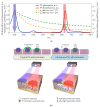Dual-Wavelength Fluorescence Monitoring of Photodynamic Therapy: From Analytical Models to Clinical Studies
- PMID: 34830963
- PMCID: PMC8616416
- DOI: 10.3390/cancers13225807
Dual-Wavelength Fluorescence Monitoring of Photodynamic Therapy: From Analytical Models to Clinical Studies
Abstract
Fluorescence imaging modalities are currently a routine tool for the assessment of marker distribution within biological tissues, including monitoring of fluorescent photosensitizers (PSs) in photodynamic therapy (PDT). Conventional fluorescence imaging techniques provide en-face two-dimensional images, while depth-resolved techniques require complicated tomographic modalities. In this paper, we report on a cost-effective approach for the estimation of fluorophore localization depth based on dual-wavelength probing. Owing to significant difference in optical properties of superficial biotissues for red and blue ranges of optical spectra, simultaneous detection of fluorescence excited at different wavelengths provides complementary information from different measurement volumes. Here, we report analytical and numerical models of the dual-wavelength fluorescence imaging of PS-containing biotissues considering topical and intravenous PS administration, and demonstrate the feasibility of this approach for evaluation of the PS localization depth based on the fluorescence signal ratio. The results of analytical and numerical simulations, as well as phantom experiments, were translated to the in vivo imaging to interpret experimental observations in animal experiments, human volunteers, and clinical studies. The proposed approach allowed us to estimate typical accumulation depths of PS localization which are consistent with the morphologically expected values for both topical PS administration and intravenous injection.
Keywords: Monte Carlo simulations; animal studies; chlorin-based photosensitizers; clinical studies; dual-wavelength fluorescence imaging; light transport; optical phantoms; photodynamic therapy.
Conflict of interest statement
The authors declare no competing interests.
Figures












Similar articles
-
Red and blue light in antitumor photodynamic therapy with chlorin-based photosensitizers: a comparative animal study assisted by optical imaging modalities.Biomed Opt Express. 2021 Jan 15;12(2):872-892. doi: 10.1364/BOE.411518. eCollection 2021 Feb 1. Biomed Opt Express. 2021. PMID: 33680547 Free PMC article.
-
Comparative analysis of single- and dual-wavelength photodynamic therapy regimes with chlorin-based photosensitizers: animal study.J Biomed Opt. 2019 Dec;25(6):1-17. doi: 10.1117/1.JBO.25.6.063804. J Biomed Opt. 2019. PMID: 31872580 Free PMC article.
-
Photodynamic therapy with chlorin-based photosensitizer at 405 nm: numerical, morphological, and clinical study.J Biomed Opt. 2018 Jun;23(9):1-9. doi: 10.1117/1.JBO.23.9.091412. J Biomed Opt. 2018. PMID: 29956507
-
Monitoring photodynamic therapy of head and neck malignancies with optical spectroscopies.World J Clin Cases. 2013 Jun 16;1(3):96-105. doi: 10.12998/wjcc.v1.i3.96. World J Clin Cases. 2013. PMID: 24303476 Free PMC article. Review.
-
Mesoscopic fluorescence tomography of a photosensitizer (HPPH) 3D biodistribution in skin cancer.Acad Radiol. 2014 Feb;21(2):271-80. doi: 10.1016/j.acra.2013.11.009. Acad Radiol. 2014. PMID: 24439340 Review.
Cited by
-
Devices and Methods for Dosimetry of Personalized Photodynamic Therapy of Tumors: A Review on Recent Trends.Cancers (Basel). 2024 Jul 8;16(13):2484. doi: 10.3390/cancers16132484. Cancers (Basel). 2024. PMID: 39001546 Free PMC article. Review.
-
Deep learning based depth map estimation of protoporphyrin IX in turbid media using dual wavelength excitation fluorescence.Biomed Opt Express. 2023 Sep 18;14(10):5254-5266. doi: 10.1364/BOE.500022. eCollection 2023 Oct 1. Biomed Opt Express. 2023. PMID: 37854564 Free PMC article.
-
Post-Operational Photodynamic Therapy of the Tumor Bed: Comparative Analysis for Cold Knife and Laser Scalpel Resection.Biomedicines. 2024 Jan 26;12(2):0. doi: 10.3390/biomedicines12020291. Biomedicines. 2024. PMID: 38397893 Free PMC article.
References
-
- Bao X., Yuan Y., Chen J., Zhang B., Li D., Zhou D., Jing P., Xu G., Wang Y., Holá K. In vivo theranostics with near-infrared-emitting carbon dots—highly efficient photothermal therapy based on passive targeting after intravenous administration. Light Sci. Appl. 2018;7:1–11. doi: 10.1038/s41377-018-0090-1. - DOI - PMC - PubMed
Grants and funding
LinkOut - more resources
Full Text Sources
Research Materials

